[四国EPO・四国ESDセンターが、みなさんにおすすめしたい!と思った事例をご紹介していきます]
多様な関係者とともに、地域での循環社会づくりを目指して / Establishing a Recycling-Oriented Society With Diverse Stakeholders / 与多方相关者一起,旨在该地区创建循环型社会
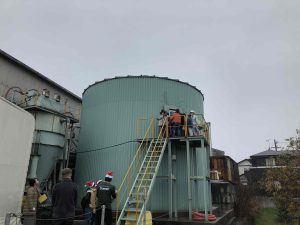
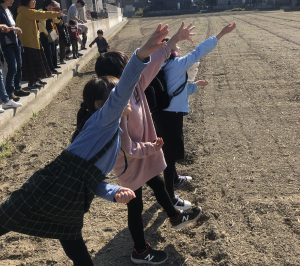
■プラント見学の様子 ■エコツアーで小麦種まき体験
Establishing a Recycling-Oriented Society With Diverse Stakeholders
In Kagawa Prefecture, which is famous for Sanuki udon, it is estimated that over 6,000 tons (flour equivalent) of uneaten udon is disposed of annually. This includes noodles cooked at udon shops that sit for too long and must be thrown away, as well as scraps produced in the manufacturing process at factories. In January 2012, various NPOs, businesses, local governments and farmers came together to form the “Udon Total Recycling Consortium” with the goal of reducing food waste by recycling the udon that would otherwise be incinerated as garbage.
With support from external organizations and the Ministry of Land, Infrastructure, Transport and Tourism, in 2013 they established a system to recycle udon scraps by using them to generate electricity and composting them. Then, through media coverage and the “Udon Total Eco Tour” aimed at general participants, they created spaces where people can learn about, observe and experience the mechanisms of recycling food waste. That same year, they also attended a debrief meeting organized by the Ministry of the Environment which opened their eyes to the problem of curbing emissions associated with food loss.
■PHOTO
A plant tour in progress
■PHOTO
Wheat seed sowing experience on an eco tour
Afterward, as a result of building relationships with diverse groups and organizations while valuing various possibilities and opportunities, they started the “Food Bank Collaborative Activity” initiative to regularly supply substandard udon to the Council of Social Welfare (as of FY 2020 a total of 2,000 servings have been donated, contributing to a reduction in food loss). Additionally, with growing momentum behind achieving SDGs and reducing food loss, they are working together with diverse stakeholders to maintain cooperative systems to solve regional food loss problems, such as participating in the Kagawa Prefecture Food Loss Reduction Promotion Conference.
It has now been 10 years since the Udon Total Recycling Consortium was formed. They plan to continue their activities for the foreseeable future, with the hopes that they will have a ripple effect on other regions. If you are interested, please take a look at their initiatives.
■Udon Total Recycling Project
https://www.udon0510.com/
与多方相关者一起,旨在该地区创建循环型社会
在以讃岐乌冬面而闻名的香川县,由于在乌冬面店煮沸后因时间过长而废弃的乌冬面,以及工厂制造过程中所产生的废料,估计每年丢弃6,000吨(按小麦粉换算)。 旨在将作为废物焚烧的乌冬面,通过纳入循环并回收利用来减少食物浪费为宗旨的「乌冬面全循环联盟」在2012 年 1 月由非营利组织、企业、地方政府、农家等多方主体所成立。
在外部组织和环境部项目等的支持下,2013年完成了产生和堆肥乌冬面残留物的回收系统。 从那时起,我们通过媒体采访和面向普通参与者的“乌冬面生态之旅”,一直在传播有关食物垃圾循环机制的信息,并创造了人们可以观察和体验它的学习场所。 同年,我们参加了环境部主办的业务报告会议,使我们认识到了减少粮食损失和浪费的课题意义。
■参观植物的情况
■通过生态旅游体验小麦播种
随后,在重视各种可能性和机会的同时,我们与各种不同的组织和机构建立了关系。作为其中的一个结果,我们开展了“食品银行联动活动”,定期向社会福祉协议会捐赠规格外的乌冬面(截至2020年已累计捐赠2000碗乌冬面,为减少食品浪费做出了贡献)。此外,随着SDGs目标的实现和减少食品浪费的呼声不断高涨,为了解决地方上的“减少食品浪费”问题,我们还参与了香川县减少食品浪费推进协议会,与各种利益相关者维持了协同工作的机制。
乌冬面全循环联盟成立了10周年。 未来,他们计划继续开展活动,同时预计其他地区也会产生连锁反应。 如果您有兴趣,请看一下我们的活动内容。
■乌冬面全循环项目
https://www.udon0510.com/
森林とまちの活力を創造する!内子バイオマス発電所 / Revitalizing Forest and Town! Uchiko Biomass Power Plant / 创造森林和城镇的活力! 内子生物质发电厂
内子バイオマス発電所は2018年10月竣工、2019年から本格稼働し、同年4月から四国電力に売電を開始、2021年10月からみんな電力へも売電を開始しました。現在では1年間で一般家庭約2500戸分の電力に相当する約1000kWを発電。森林率約77%である内子町の森林資源を活用した、地域密着型バイオマス発電として注目されています。
※世帯当たり3,254.4kWh/年で算出(出典:電気事業連合会「原子力・エネルギー図画集2015」)
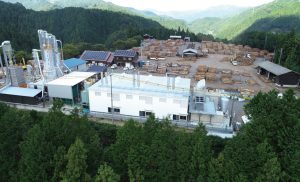
■中央の白い建物が内子バイオマス発電所、その左がペレット製造のプラントです
豊かな森林資源を誇る内子町ですが、人工林は放置された状態が続くと、良質な木材が生産できないばかりか、森林の保水力が弱まったり、表土流出や土砂崩れを起こしたりするなどの危険が高まります。適度な伐採、間伐などが行われることが必要ですが、木材価格の低迷による木材生産の低下とともに、間伐後に回収されなかったり、曲がっているなどの理由で廃棄されたりする未利用材の活用が課題となっていました。
そこで、内子町バイオマスタウン構想のもと、地元の有限会社内藤鋼業が未利用材を活用して木質ペレットを製造し、公共施設のペレットストーブやボイラーなどで利用する取組が始まりました。しかし、冬に需要が限定されてしまうことが課題となり、年間を通して安定供給するために、ペレットによる発電所が構想されたといいます。内子バイオマス発電所は、内藤鋼業を中心に地元の企業が出資、地元金融機関が融資し、シン・エナジー株式会社(神戸市)の設計・施工によって建設されました。ペレットの原料となる原木の供給は、隣接する内子森林組合が担っています。
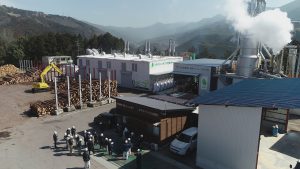
■視察も受け入れています
木質ペレットの製造にはいくつもの工程があります。まず、原木をチッパーと呼ばれる機械で細かいチップにします。そのままでは水分が多いため、木の皮などを燃やして作った温風で乾燥させ、さらに細かく砕いておが粉にします。おが粉をペレット製造機に入れ、ぎゅっと押し固めて粒状のペレットが作られます。
そして、隣接するバイオマス発電所では、ガス化装置でペレットから発生させたガスを燃料に、発電装置のエンジンを動かして発電します。発電時に出る温水から、温水発電も行っています。
また、ペレット製造時にチップを乾燥させるために燃やす木の皮などから発生する灰は、セメントなどを加えてバイオマスストーンとして再生され、林道の舗装などに活用しています。
ペレットの原料となる原木を集める仕組みにも工夫があります。それが町営の「木こり市場プロジェクト」。出荷者が軽トラで未利用材を森林組合の収集場所へ持ち込むと、1トンあたり8000円で買い取ってもらうことができ、そのうちの5000円は現金で、残りの3000円は地域の50ほどの店舗で使える地域通貨「ドン券」で受け取ります(令和4年3月現在)。令和2年度は576.6トンの出荷があったそうです。このように比較的高額の買い取り価格が設定され、出荷が促されて安定的に原木を入手できるとともに、地域でお金が循環する仕組みが定着しています。
これらの取組が高く評価され、内子バイオマス発電所は令和2年度新エネ大賞(新エネルギー財団会長賞)「地域共生部門」に輝きました。
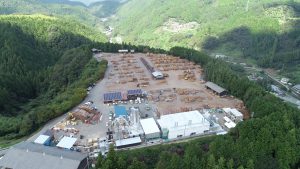
■内子森林組合に隣接しています
海外に依存する化石燃料を使う発電は、CO2を排出し、地球温暖化の原因になっています。一方、木質バイオマス発電は自然資源からつくられる再生可能エネルギーであり、発電時にCO2が排出されますが、森林で樹木が生育するときにCO2を吸収することから、全体として見れば大気中のCO2の量に影響を与えないので、カーボンニュートラルとされます。また、内子バイオマス発電所は海外や遠い地域から森林資源を購入するのではなく、隣接する内子町内の森林から生じる未利用材を活用することから、運搬などによるCO2の排出や労力などを最小限に抑えることができます。また、森林資源の購入資金が外の地域に流出せずに域内で再投資されることにより、地域の活性化につながります。さらに、地域における森林資源の需要が高まることによって、どんどん森林に人の手が入って整備が進み、健全な森林が保たれ、防災や水の涵養の機能も高まります。このようにプラスの循環が生まれ、町の活性化が進むことが期待されています。
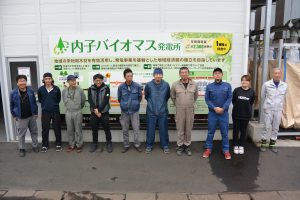
■内子バイオマス発電所の運営を担う皆さん
2022年4月には、町内の龍王地区で「内子龍王バイオマス発電所」が着工予定となっています。内藤鋼業が製造する木質ペレットを使った発電とともに、副産物として発生する熱を温浴施設とフィットネスクラブに供給するコジェネプラントが建設される計画で、内子町におけるバイオマス発電の横展開が始まっています。内子バイオマス発電所は随時見学を受け付けているので、森林資源活用による再生可能エネルギーが創出される現場を体感することができます。
【事業主】内子バイオマス発電合同会社
愛媛県喜多郡内子町寺村2478-1
https://www.symenergy.co.jp/service/area_energy/uchiko/
【運営管理】有限会社内藤鋼業
http://naito-kogyo.co.jp/
Revitalizing Forest and Town! Uchiko Biomass Power Plant
The Uchiko Biomass Power Plant finished construction in October 2018 and came online in 2019. It began selling electricity to Shikoku Electric Power Company in April of the same year, and to Minna Denryoku in October 2021. Currently it produces about 1,000 kW of electricity, or roughly the amount needed to power about 2,500 homes over one year. It is garnering attention as a form of community-based biomass power generation that effectively utilizes the resources of Uchiko Town, which is 77% forest.
*Calculated based on a figure of 3,254.4 kWh/year for one household (Source: Federation of Electric Power Companies, “Graphical Flip-chart of Nuclear & Energy Related Topics, 2015”)
■The white building in the center is the biomass power plant. To its left is the pellet production plant.
Though Uchiko Town boasts abundant forest resources, when planted forests are left alone for too long not only do they stop producing high-quality lumber, the risks of reduced water retention, topsoil runoff and landslides also increase. Moderate logging and thinning is necessary, but the decline in lumber production due to falling prices, along with what to do with wood that wasn’t collected after thinning or that was discarded for various reasons such as being bent, was becoming an issue.
And so, under the Uchiko Town Biomass Town Plan, the local company Naito Kogyo Co., Ltd. began utilizing the unused wood to make wood pellets, for use in pellet stoves and boilers in public facilities. However, the problem was that demand for this was limited to winter. In order to stabilize it throughout the year, a plan to make a pellet-powered power plant was devised. The Uchiko Biomass Power Plant was designed and constructed by SymEnergy Co., Ltd. (Kobe), with investments from local companies — centering around Naito Kogyo — and financing by local financial institutions. The adjoining Uchiko Forest Association is responsible for providing the raw lumber used to make the pellets.
■The plant also accepts inspections.
Producing the wood chips involves a number of processes. First, raw lumber is fed into a machine called a “chipper” and ground into fine chips. Because the water content is high, these chips are dried with warm air currents from burning tree bark and other waste materials, and then further processed into sawdust. Finally, the sawdust is run through a pellet-making machine, which presses and hardens it into granular pellets.
At the adjoining biomass power plant, gas is extracted from the pellets using a gasifier, which is used to fuel an engine generator and produce electricity. The hot water created as a byproduct is used to generate electricity, too.
Additionally, the ash generated during the drying stage of the pellet production process is added to cement and other materials and recycled as biomass stone, which is used as pavement for things like forest roads.
There is also a clever system for gathering the lumber used as raw materials for the pellets. Namely, the municipal “Lumberjack Market Project.” Shippers take unused materials to the Forest Association collection site via light truck, and the Association will buy it for 8,000 yen per ton: 5,000 yen to be paid in cash, and the remaining 3,000 yen to be paid as “Don Coupons” useable at around 50 local retailers (as of March 2022). In 2020, there were 576.6 tons shipped. In this way, a relatively high purchase price is established, promoting shipments and providing a stable source of raw lumber, while at the same time creating a system for money to circulate within the community.
In recognition of these initiatives, the Uchiko Biomass Power Plant was awarded the 2020 New Energy Award (New Energy Foundation Chairman’s Award) in the “community coexistence” category.
■The Uchiko Forest Association is adjacent.
Power generation using fossil fuels, which are dependent on foreign countries, produces CO2 which causes global warming. On the other hand, wood biomass power generation creates renewable energy from natural resources, and although it also emits CO2 it is considered carbon neutral because that CO2 is absorbed when trees grow in the forest, meaning that when looked at from a broader point of view there is no net addition to the overall level of CO2 in the atmosphere. In addition, because the Uchiko Biomass Power Plant does not purchase forest resources from distant regions or overseas, but rather utilizes unused resources from the forests around Uchiko Town, the CO2 emissions and labor associated with transportation are minimized. And, because the funds for the purchase of forest resources are reinvested in the community instead of being diverted to other regions, it also contributes to the revitalization of the region. Further, by increasing demand for regional forest resources, people will tend to the forests more, keeping them healthy and helping to prevent disasters and increase water cultivation. This in turn creates a positive feedback loop, which will hopefully lead to the revitalization of the town, as well.
■The management of the Uchiko Biomass Power Plant.
The Uchiko Ryuo Biomass Power Plant is scheduled to begin construction in Uchiko’s Ryuo District in April 2022. There are also plans to begin horizontal expansion, such as building a cogeneration plant which will divert the waste heat created when generating electricity with Naito Kogyo’s wood pellets, and use it to heat a public bath facility and fitness club. Tours of the Uchiko Biomass Power Plant are available upon request, so visitors can experience firsthand the process of generating renewable electricity by utilizing forest resources.
[Owner] Uchiko Biomass Power LLC
2478-1 Teramura, Uchiko-cho, Kita-gun, Ehime-ken
https://www.symenergy.co.jp/service/area_energy/uchiko/
[Operator] Naito Kogyo Co., Ltd.
创造森林和城镇的活力! 内子生物质发电厂
内子生物质发电厂于2018年10月竣工,并于2019年开始全面运营,同年4月开始向四国电力销售电力。自2021年10月起,该厂还开始向株式会社UPDATER(旧MINNA电力株式会社)出售电力。目前,该厂每年发电约1000 kW,相当于约2500户家庭的电力需求。该生物质发电厂利用内子町森林资源的77%,成为备受关注的地方紧密型生物质发电厂。
* 每户相当于 3,254.4 kWh /年的计算(资料来源:日本电气事业联合会,“核电与能源图画书 2015”)
■中间的白色建筑是内子生物质发电厂,左边是颗粒制造厂。
内子町虽然拥有丰富的森林资源,但如果继续放置人工林,不仅无法生产出高质量的木材,而且森林的保水能力也将减弱,表土流失或山体滑坡等风险也将会增加。 适当的伐木和疏伐是必要的,但随着木材价格低迷导致木材产量下降,活用疏伐后未收集或因弯曲或其他原因而被丢弃的未使用的木材已成为了一个课题。
因此,在内子町生物质城镇的概念下,当地的有限会社内藤钢业活用未使用的木材制造了木屑颗粒,并将其用于公共设施的颗粒炉和锅炉。 然而,仅限于只有冬季才需要的事实成为了课题,为了确保全年的稳定供应,构想了一个使用木屑颗粒的发电厂。 内子生物质发电厂由新能源株式会社(神户市)设计・施工并建造,内藤钢业为首的当地企业投资,当地金融机构融资。 用作颗粒原料的原木由相邻的内子林业协会负责供应。
■接受视察
木屑颗粒的生产涉及几个过程。 首先,用削片机的机器将原木制成细木片。 由于水分很多,因此用燃烧木皮等而产生的暖空气来干燥,然后将其粉碎成细块制成锯末。 将锯末放入制粒机中挤压制成颗粒。
然后,在相邻的生物质发电厂,用气化炉装置将颗粒产生的气体作为燃料,驱动发电机组的发动机使其发电。 我们还利用发电过程中产生的热水,进行热水发电。
此外,在颗粒制造过程中用于燃烧的木皮和其他材料产生的灰烬,通过添加水泥和其他材料作为生物质石回收,用于铺设林道。
还有一种收集原木的机制,原木是木屑颗粒的原料。 这就是城镇上经营的“伐木工人市场项目”。 当出货人用轻型卡车将未使用的木材带到林业合作社的收集点时,他们可以以每吨8,000日元的价格出售,其中5,000日元为现金,其余3,000日元以「礼品券」的形式收款,这是一种地区货币,可以在该地区的约50家商店使用(令和4年3月现在)。 在令和2年,出货量为576.6吨。 通过这种方式,设定了相对较高的购买价格,并鼓励发货以确保稳定收购原木,并在该地区生根发芽。
这些努力得到了高度评价,内子生物质发电厂获得了“地区共生部门”的令和2年新能源奖(新能源财团会长奖)。
■毗邻内子林业合作社
使用依赖海外的化石燃料发电会排放二氧化碳,成为全球变暖的原因。另一方面,木质生物质发电利用再生能源从自然资源中制造,发电时会排放二氧化碳,但由于森林生长时吸收二氧化碳,因此从整体上看对大气中的二氧化碳含量没有影响,被认为是碳中和的。此外,内子生物质发电厂不是从海外或遥远地区购买森林资源,而是利用毗邻的内子町未利用的森林资源,可以将由于运输等导致的二氧化碳排放和劳动力等降到最低限度。此外,由于森林资源购买的资金不会流向外部地区,而是在该地区再投资,这有助于促进地方经济的活性化。此外,随着对森林资源的需求增加,森林中将越来越多地投入人力,整个森林得以保持健全,增强防灾和补水的功能。因此,可以期待产生积极的循环,推动城镇的活力。
■负责运营内子生物质发电厂的人们
2022年4月,在该城镇的龙王区计划建设「内子龙王生物质发电厂」。 除了使用内藤钢业制造的木屑颗粒发电外,还计划建设一个热电联产工厂,该热电联产工厂将作为副产品产生的热量提供给热水浴设施和健身俱乐部,并且已经开始在内子町横向扩展生物质发电。 内子生物质发电厂随时可接受参观,因此您可以在现场体验利用森林资源创造的可再生能源。
【企业主】内子生物质发电有限责任公司
爱媛县北郡内子町寺村2478-1
https://www.symenergy.co.jp/service/area_energy/uchiko/
【运营管理】有限公司内藤钢业
コオロギで目指す食料難と食品ロスの課題の同時解決/ Solving Food shortages and Food Loss by Using Crickets / 利用蟋蟀同时解决食物难和食物浪费的课题
ある企業からコオロギせんべいが発売され、昆虫食への注目が集まってきています。そのせんべいにも使われた食用コオロギを製造している会社が、徳島県にある株式会社グリラスです。
グリラスは、徳島大学でコオロギを使って、受精卵からどうやって生き物のかたちが作られるかを研究していた渡邉崇人さんが中心となり、2019年に立ち上げました。現在は、鳴門市と美馬市に生産拠点を設け、コオロギの生産や食品原材料の生産を行っています。
■なぜコオロギなのか
コオロギにはタンパク質が多く含まれていること、雑食性で餌を選ばないことから、食品ロスになっている農業残さや加工残さを餌にできること、出荷まで約30日と短期間であり、狭いスペースでも大量に飼育できることが、コオロギに着目した理由です。グリラスでは、熱帯から亜熱帯地域に住むフタホシコオロギという種を使い、温度管理した空間で年間を通して飼育しています。栄養分としては、コオロギをまるごと粉にするため、タンパク質のほか、ミネラルやビタミンが含まれています。
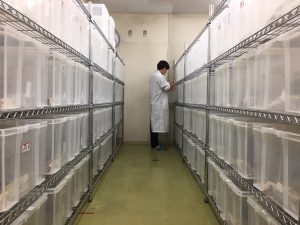
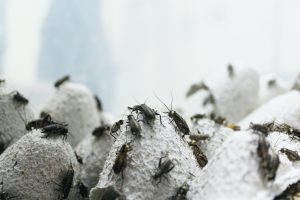
■昆虫食を当たり前に
同社では、コオロギを生活の中で当たり前に、朝起きた時から寝るまで、商品を買って食べようと思えば手に取れる商品があるという状況を作っていきたいと考えています。すでに、お菓子や主食・主菜になるカレーやパンが発売されており、街のお店やグリラスのネットショップ「グリラスオンライン」で購入することができます。また、徳島県内では、コオロギメニューを提供する飲食店も増えてきており、徐々に身近なものになっています。今後の目標は、朝ごはんとして食べられるような軽い食事のものから、夜寝る前にお酒を飲みながらおつまみにできるようなものなど、ラインナップとして取り揃えていくことだそうです。

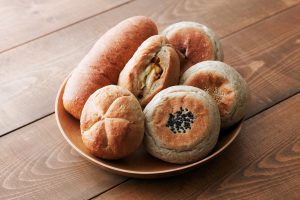
■これからのチャレンジ
世界的に食品ロスが問題となっている一方で、食べるものに困る途上国の現状があります。途上国と先進国で出る食品廃棄物や食品ロスを原料にした餌でコオロギを育て、途上国と先進国の食品ロス削減と、飢餓に直面する地域へのタンパク質循環につなげていこうと計画しています。
グリラスでは、廃校の生産拠点としての活用や、地域での雇用を生み出すことで地元住民や移住者を採用し、地方都市の活性化にも貢献しています。来年春には、さらに拠点と職員を増やし、事業を拡張していく計画があり、国内外のさまざまな課題の同時解決を目指しています。
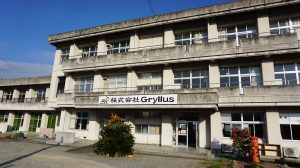
●株式会社グリラス
https://gryllus.jp/
●オンラインショップ
https://gryllus-online.jp/
■Solving Food shortages and Food Loss by Using Crickets
A company started selling Cricket Senbei, bringing attention to insect-based foods. The company that produces the edible crickets used in those Senbei is Gryllus Co., Ltd in Tokushima prefecture.
Gryllus was founded in 2019, largely through the efforts of Hiroto Watanabe, a researcher at Tokushima University who was studying the gestation cycle of crickets. Now, it produces crickets and food product ingredients at its facilities in Naruto and Mima Cities.
■Why Crickets?
There are several reasons. First, crickets are excellent sources of protein. Since they’re omnivorous, they can be fed with waste products from agriculture and food processing that would normally become food loss. And, it’s possible to raise a large number of crickets in a small space in just 30 days. Gryllus uses the cricket species called Gryllus bimaculatus, which is found in tropical and subtropical regions. By using a temperature controlled space, they can be raised year-round. Since the entire cricket is processed into a powder, the resulting product is rich in protein, minerals and vitamins.
■Making a World Where Insect-Based Foods Are Normal
The company wants to create a reality where crickets are a part of everyday life, and anybody can access products made from them at any time from morning to night. Snacks and main dishes such as curry and bread are already being sold in local shops and the Gryllus online shop, “Gryllus Online”. In addition, the number of restaurants in Tokushima offering cricket dishes are increasing. Slowly, crickets are becoming something
“familiar”. Their next goal is to build on this progress, and expand their product line to include light breakfast meals and late-night snacks to enjoy with alcohol.
■The Next Challenge
Even as the world grapples with the problem of food loss, developing countries also struggle with food shortages. By utilizing the food waste and food loss in developing and developed countries as feed for raising crickets, food loss in those countries could be reduced, and turned into protein for countries facing hunger.
Gryllus is contributing to the revitalization of local cities by repurposing abandoned schools as production sites, as well as increasing employment by hiring locals and out-of-towners. Next spring, they aim to expand their operations by further increasing the number of sites and employees, while simultaneously tackling various problems both inside and outside of the country.
・Gryllus Co., Ltd
https://gryllus.jp/
・“Gryllus Online”.the Gryllus online shop,
https://gryllus-online.jp/
■利用蟋蟀同时解决食物难和食物浪费的课题
有一家公司推出了使用蟋蟀的脆饼干,从而引起了人们对昆虫食品的关注。用于这次脆饼干里的蟋蟀是一家生产食用蟋蟀的公司,即德岛县的格里拉斯公司(GRYLLUS Company)。
格里拉斯公司是,在德岛大学研究蟋蟀是如何从受精卵演变成生物的,以渡边崇人为中心2019年创立的公司。目前,在鸣门市和美马市建立了生产基地,生产蟋蟀和食品原料。
■为什么是蟋蟀?
蟋蟀含有大量的蛋白质,由于杂食性,不选择食物,可以喂养剩余的食品和加工时的残留物,约30天的短时间就可以出货,即使在狭窄的空间,也可以大量饲养,这就是为什么专注于蟋蟀的原因。在格里拉斯,使用栖息在热带和亚热带地区的叫富塔霍希种的蟋蟀,在控制温度的空间里全年饲养。作为营养成分,会把蟋蟀整个进行粉碎,因此它不仅含有蛋白质、还含有矿物质和维生素。
■把昆虫食品做成理所当然
本公司想创造一种,含蟋蟀的食品在生活中是司空见惯,从早上起床到睡觉,如果你打算买一些含蟋蟀的食品,就可以随时买到的环境。目前已经销售了成为主食和主菜的含蟋蟀的咖喱和面包,可以在城市商店或格里拉斯网店「格里拉斯在线」上购买这些产品。此外,在德岛县,提供蟋蟀菜单的餐馆越来越多,而且越来越被大家所熟悉。今后的目标是,从可以作为早餐吃的清淡的饭菜,到晚上睡觉前一边喝酒一边吃的小菜,为产品的多样化做准备。
■今后的挑战
虽然全球食品浪费是一个问题,但发展中国家目前在食物方面遇到了困难。我们计划以发展中国家和发达国家的食品废弃物和浪费的食品为饲料来养殖蟋蟀,以减少发展中国家和发达国家的食品浪费,并将蛋白质循环到面临饥饿的地区。
在格里拉斯,可以把废弃的学校作为生产基地,通过在当地创造就业机会来雇用当地居民和移居者,为振兴地方城市而做出贡献。明年春天,我们计划进一步增加基地和员工人数,扩大业务,同时解决国内外的各种问题。
格里拉斯公司
https://gryllus.jp/
网上商店
https://gryllus-online.jp/



